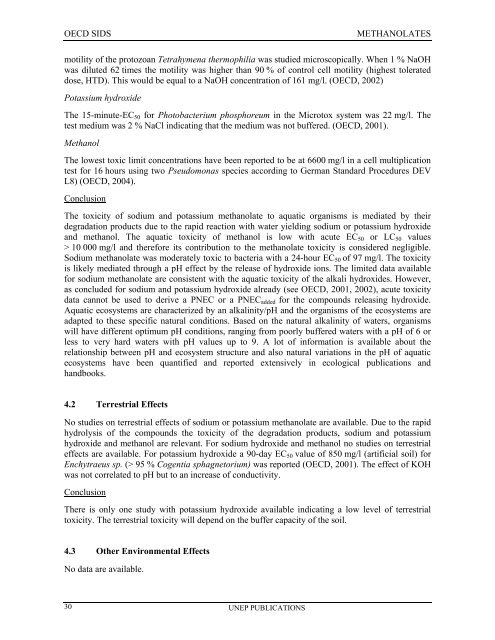Sodium methanolate - ipcs inchem
Sodium methanolate - ipcs inchem
Sodium methanolate - ipcs inchem
You also want an ePaper? Increase the reach of your titles
YUMPU automatically turns print PDFs into web optimized ePapers that Google loves.
OECD SIDS<br />
METHANOLATES<br />
motility of the protozoan Tetrahymena thermophilia was studied microscopically. When 1 % NaOH<br />
was diluted 62 times the motility was higher than 90 % of control cell motility (highest tolerated<br />
dose, HTD). This would be equal to a NaOH concentration of 161 mg/l. (OECD, 2002)<br />
Potassium hydroxide<br />
The 15-minute-EC 50 for Photobacterium phosphoreum in the Microtox system was 22 mg/l. The<br />
test medium was 2 % NaCl indicating that the medium was not buffered. (OECD, 2001).<br />
Methanol<br />
The lowest toxic limit concentrations have been reported to be at 6600 mg/l in a cell multiplication<br />
test for 16 hours using two Pseudomonas species according to German Standard Procedures DEV<br />
L8) (OECD, 2004).<br />
Conclusion<br />
The toxicity of sodium and potassium <strong>methanolate</strong> to aquatic organisms is mediated by their<br />
degradation products due to the rapid reaction with water yielding sodium or potassium hydroxide<br />
and methanol. The aquatic toxicity of methanol is low with acute EC 50 or LC 50 values<br />
> 10 000 mg/l and therefore its contribution to the <strong>methanolate</strong> toxicity is considered negligible.<br />
<strong>Sodium</strong> <strong>methanolate</strong> was moderately toxic to bacteria with a 24-hour EC 50 of 97 mg/l. The toxicity<br />
is likely mediated through a pH effect by the release of hydroxide ions. The limited data available<br />
for sodium <strong>methanolate</strong> are consistent with the aquatic toxicity of the alkali hydroxides. However,<br />
as concluded for sodium and potassium hydroxide already (see OECD, 2001, 2002), acute toxicity<br />
data cannot be used to derive a PNEC or a PNEC added for the compounds releasing hydroxide.<br />
Aquatic ecosystems are characterized by an alkalinity/pH and the organisms of the ecosystems are<br />
adapted to these specific natural conditions. Based on the natural alkalinity of waters, organisms<br />
will have different optimum pH conditions, ranging from poorly buffered waters with a pH of 6 or<br />
less to very hard waters with pH values up to 9. A lot of information is available about the<br />
relationship between pH and ecosystem structure and also natural variations in the pH of aquatic<br />
ecosystems have been quantified and reported extensively in ecological publications and<br />
handbooks.<br />
4.2 Terrestrial Effects<br />
No studies on terrestrial effects of sodium or potassium <strong>methanolate</strong> are available. Due to the rapid<br />
hydrolysis of the compounds the toxicity of the degradation products, sodium and potassium<br />
hydroxide and methanol are relevant. For sodium hydroxide and methanol no studies on terrestrial<br />
effects are available. For potassium hydroxide a 90-day EC 50 value of 850 mg/l (artificial soil) for<br />
Enchytraeus sp. (> 95 % Cogentia sphagnetorium) was reported (OECD, 2001). The effect of KOH<br />
was not correlated to pH but to an increase of conductivity.<br />
Conclusion<br />
There is only one study with potassium hydroxide available indicating a low level of terrestrial<br />
toxicity. The terrestrial toxicity will depend on the buffer capacity of the soil.<br />
4.3 Other Environmental Effects<br />
No data are available.<br />
30<br />
UNEP PUBLICATIONS
















